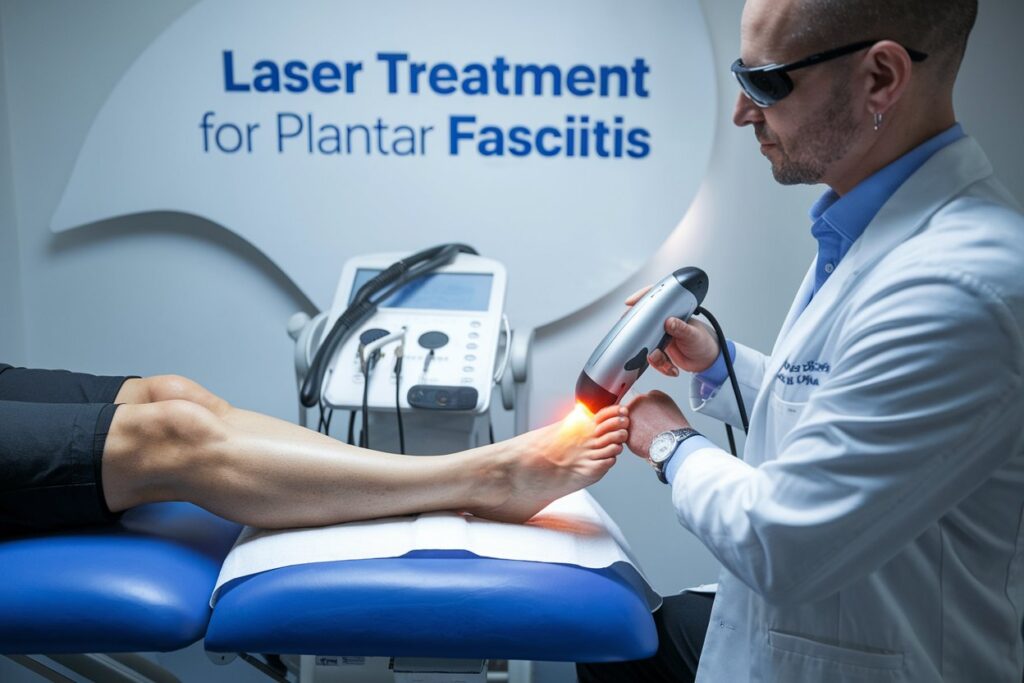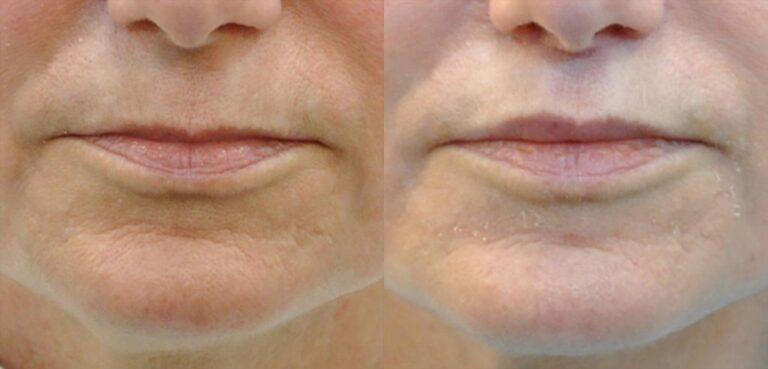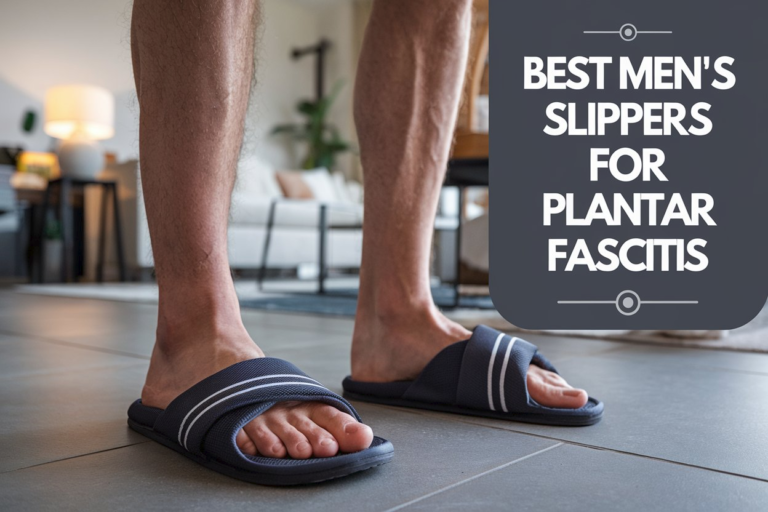Laser Treatment for Plantar Fasciitis Relief

Imagine a local runner, once excited to hit the pavement, now wincing with every step because of plantar fasciitis. This condition affects millions, making simple tasks hard. Traditional treatments often just cover up the pain, leaving many feeling stuck and hopeless. But, new options like laser treatment for plantar fasciitis are showing promise, offering lasting relief without surgery.
Deep tissue laser therapy is becoming more popular. It helps athletes and regular people find a way to heal faster and reduce pain. This article will look into how this advanced treatment can help you move better and improve your life. It will also cover important details about this common foot problem.
Table of Contents
Understanding Plantar Fasciitis
Plantar fasciitis is a common issue where the plantar fascia, a tissue band, gets inflamed. It connects the heel bone to the toes. It often hits people who do the same activities over and over, like runners or those with foot problems. Knowing about plantar fasciitis helps people find the best plantar fasciitis treatment options.
The main sign is heel pain, especially when you first get up in the morning or after sitting for a long time. This pain can really affect your daily life and activities. Spotting the plantar fasciitis symptoms early is key to managing and treating it well.
It’s a big deal, with up to 15% of all foot problems in adults being from it. Many people look for ways to ease their pain, as 80% see better symptoms with treatments like MLS Laser Therapy. This shows how important it is to get the right treatment that fits your needs.
Causative Factors of Plantar Fasciitis

Understanding what causes plantar fasciitis helps us prevent it and find the right treatment. Many things can lead to this common foot problem. It affects people of all ages more often now.
- Being overweight: Carrying extra weight puts more pressure on the plantar fascia.
- Age: People over 40 are more likely to get this condition.
- Flat feet or high arches: These can cause strain because of imbalances.
- Tight calf muscles: Tight muscles can reduce how well the foot is supported.
- Unusual walking patterns: Walking differently can make you more likely to get it.
- Standing or walking on hard surfaces: Being on hard surfaces for a long time can make it worse.
- Physical activities: Sports like running and basketball can increase your risk.
Studies show that these factors greatly increase the chance of getting plantar fasciitis. For example, athletes, especially runners, face a higher risk from the repeated stress. Also, wearing shoes that don’t support your feet well can make symptoms worse.
| Risk Factor | Impact |
|---|---|
| Being overweight | Increased pressure on the foot |
| Age | Higher incidence in older individuals |
| Flat feet or high arches | Biomechanical imbalances |
| Tight calf muscles | Reduced foot support |
| Unusual walking patterns | Increased risk of strain |
| Standing on hard surfaces | Prolonged discomfort |
| High-impact sports | Repetitive foot stress |
Knowing what causes plantar fasciitis helps us prevent it and find the right treatment. This can lead to better foot health and overall well-being.
Symptoms and Diagnosis of Plantar Fasciitis
Plantar fasciitis brings sharp, stabbing pain near the heel, especially when you first get up or after sitting for a long time. This pain can get better with movement but gets worse with more standing or activity. It makes daily activities hard.
To diagnose plantar fasciitis, doctors do a detailed check-up and look at your medical history. They check for tenderness and inflammation in the plantar fascia. Sometimes, X-rays or MRIs are needed to rule out other heel pain causes, like stress fractures or rheumatoid arthritis.
About 2 million Americans get plantar fasciitis every year. It’s a big health issue. Knowing the signs and getting it diagnosed early helps in treating it better.
Conventional Treatments for Plantar Fasciitis
Plantar fasciitis often causes sharp pain in the heel. It leads to various traditional plantar fasciitis treatments. These aim to ease pain and help heal. Common methods include:
- Rest and ice application to reduce swelling
- Over-the-counter pain relievers for immediate relief
- Corticosteroid injections for inflammation control
- Physical therapy focused on stretching and strengthening exercises
- Use of orthotic devices to provide arch support
- Night splints to maintain foot position during sleep
If these methods don’t work well, surgery might be an option. But, these traditional plantar fasciitis treatments might only help for a short time. They don’t always fix the real problems. This pushes people to look for non-invasive treatment options that work better over time.
Looking into chiropractic care is a good idea for plantar fasciitis. It can tackle the deep causes of the problem. This type of care might lead to better healing and recovery.
Exploring Laser Treatment for Plantar Fasciitis

Laser treatment is now a top choice for plantar fasciitis. It uses advanced laser technology to ease pain and help heal without surgery. This method is non-invasive and targets the root of the problem.
How Laser Therapy Works
Laser therapy for plantar fasciitis uses high-intensity light that goes deep into tissues. This helps cut down inflammation and kickstarts the healing process naturally. The laser energy helps fix cells, giving relief from the heel pain of plantar fasciitis.
Types of Laser Therapy
There are different laser therapies for plantar fasciitis. The main ones are:
| Type of Laser | Wavelength/Intensity | Depth of Penetration | Typical Use |
|---|---|---|---|
| Class 3 Laser | Low to moderate intensity | Shallow tissues | Acute pain relief |
| Class 4 Laser | High intensity | Deep tissues | Chronic conditions, including plantar fasciitis |
Class 4 lasers are best for chronic conditions because they can reach deep into tissues. They’re great for people with long-term plantar fasciitis pain. Many studies show that laser therapy boosts recovery and cuts down on pain.
Benefits of Laser Treatment for Plantar Fasciitis
Laser treatment is a great choice for those with plantar fasciitis. It’s a non-invasive option, unlike traditional methods. This makes it a preferred choice for many.
Non-Invasive Approach
Laser treatment doesn’t require surgery or invasive procedures. This means less risk and more pain relief for patients. Choosing laser therapy means a painless recovery, making healing easier.
Promotes Fast Healing
This therapy helps heal quickly. Lasers improve blood flow and boost collagen production. These actions reduce inflammation and speed up recovery from plantar fasciitis.
Many patients feel less pain and move better after laser therapy. This shows how effective this treatment is.
| Feature | Details |
|---|---|
| Session Length | Approximately 15 minutes per session |
| Recovery Period | Full recovery may take a few weeks |
| Success Rate | Higher success rate compared to other topical therapies |
| Side Effects | No known side effects reported |
| Pain Relief | Many patients experience less pain within days following treatment |
| Combination Therapy | Can be combined with medications and physical therapy |
For better foot health, consider the benefits of exercise. Regular physical activity can help with laser therapy and improve recovery.
Laser Therapy vs. Traditional Treatments
Looking into plantar fasciitis treatments, we see big differences between laser therapy and old-school methods. Traditional treatments like corticosteroid shots mainly help with symptoms. But, they might not fix the root cause of the problem. Laser therapy, on the other hand, is a new, non-invasive way that works on healing at a cell level.
Research shows that laser therapy can really help people feel better. A study found that laser therapy worked better than traditional treatments in easing pain after three months. Those who got laser therapy saw less tenderness. On the other hand, shots could lead to problems like the plantar fascia tearing.
Laser therapy has big benefits, especially in giving long-lasting relief. For example, after just three sessions, people using MLS Laser Therapy felt 51% to 78% less pain. Also, 80% of people said their symptoms got better, showing how effective laser therapy is for foot pain.
When choosing a treatment, it’s important to look at the pros and cons of each option. With more research backing up laser therapy as safe and effective, it’s a strong choice for lasting relief.
What to Expect During Laser Treatment Sessions
If you’re thinking about laser therapy for plantar fasciitis, you’ll find it easy and quick. Each session is short and aims to ease heel pain with little discomfort.
Session Length and Frequency
A typical laser treatment for plantar fasciitis lasts 15 to 30 minutes. It’s perfect for those with tight schedules. At first, you might go to two to three sessions a week to track progress closely.
As you get better, you’ll go less often, making it easier to fit into your schedule. Most people see results after 6 to 12 sessions. The plantar fasciitis laser treatment process changes based on how bad the condition is, making each session tailored to you. The goal is to heal effectively while keeping you comfortable.
Knowing what to expect from laser therapy session details helps you feel sure about this treatment. It’s all about focusing on you for the best heel pain relief.
Success Rates of Laser Treatment for Plantar Fasciitis
Laser therapy for plantar fasciitis has shown great success, helping many people feel less pain and move better. Studies show that 80% of patients get better after a few sessions. This makes it a top choice for treating plantar fasciitis.
Each laser session is about 15 minutes long. Many people start to feel better right after the first session. This quick effect makes laser therapy very appealing for those in constant pain.
Most research looks at heel pain in general, but it still supports using laser for plantar fasciitis. Laser therapy helps fix damaged tissues and boosts blood flow. This makes it a key tool in treating plantar fasciitis.
Adding laser therapy to a treatment plan can lead to great results. It’s a safe way to treat both new and long-term plantar fasciitis. It offers a gentle yet effective way for people to improve their lives.
Potential Risks and Side Effects
Laser treatment for plantar fasciitis is safe and effective for pain relief. Most patients see few side effects, making it a good choice over more invasive methods. The risks of laser treatment are low, but some might feel temporary swelling or discomfort where treated. Talking openly with a practitioner about any health concerns can help avoid these issues.
The side effects of plantar fasciitis laser therapy are usually small. Many patients see big improvements without any bad reactions. This treatment is non-invasive, which makes it safer. Surgery, on the other hand, has a higher risk of problems, making laser therapy more attractive for heel pain.
- Temporary swelling
- Discomfort at the treatment area
- No significant long-term effects
- Lower risk than surgical treatments
Even with minor risks, the benefits usually outweigh them. Laser therapy helps heal by improving blood flow and metabolism without surgery or injections. It’s a good choice for many patients, especially when they’re recovering.
| Criteria | Laser Therapy | Surgical Treatment |
|---|---|---|
| Invasiveness | Non-invasive | Invasive |
| Risk of Complications | Low | Higher |
| Recovery Time | Fast (sessions last ~15 mins) | Longer |
| Known Side Effects | None | Possible |
Comparative Cost of Treatment Options
Looking at the cost of laser therapy for plantar fasciitis, it’s clear it’s a smart choice for saving money over time. Different treatments for plantar fasciitis have various costs. This depends on the method you pick.
Here are the typical costs for common treatments for plantar fasciitis:
| Treatment Option | Average Cost |
|---|---|
| Surgery | $3,000 – $10,000 |
| Cortisone Injections | $100 – $300 per injection |
| Dry Needling | $70 – $200 per session |
| Ultrasound Therapy | $50 – $200 per session |
| Stem Cell Treatments | $2,000+ |
| Laser Treatment | $200 – $500 per session |
| Custom Orthotics | $200 – $800 |
| Shockwave Therapy | $150 – $200 per session |
Laser treatment might seem pricier at first, especially when compared to dry needling or ultrasound. But it’s more efficient, so you might need fewer sessions. This can lower your overall costs. Low-Level Laser Therapy (LLLT) is great because it doesn’t involve surgery, saving you money.
Using laser treatment can lead to big savings over time. It cuts down on the need for medicines and follow-up treatments. So, while the upfront cost of laser therapy for plantar fasciitis might seem high, it’s a good deal in the long run for those looking for relief.
Who is a Candidate for Laser Therapy?
Finding the right candidates for laser treatment is crucial for those with chronic plantar fasciitis. Those who haven’t seen relief with traditional treatments might benefit from this method. It’s a non-invasive option that helps with quick recovery.
People with certain health issues or on other treatments should talk to doctors before trying MLS laser therapy. A detailed check-up can show if this therapy is right for them.
Treatment usually needs several sessions. Most people need six to twelve sessions over two to three weeks. Each session is 20-30 minutes long, making it a fast process.
The MLS Laser Therapy uses both hot and cold laser technology for pain relief. It’s FDA-approved and has no downtime, so patients can go back to their daily life right away.
| Criteria | Details |
|---|---|
| Condition Treated | Chronic plantar fasciitis, Achilles tendonitis, sports injuries |
| Number of Sessions | 6-12 sessions recommended for optimal results |
| Session Duration | 20-30 minutes per session |
| Recovery Time | No downtime; immediate return to activities |
| FDA Approval | Yes, safe and effective with no reported side effects |
| Cost per Session | Approximately $60 |
Patients should look into their options to make smart health choices. Detailed assessments can lead to the best treatment plans, improving life quality.
For more info and advice, check out this informative article. It offers insights on health topics related to this.
Patient Testimonials and Case Studies
Real-life stories show how laser treatment changed lives for the better. Many people talk about the big pain relief they got from laser therapy. They say it made their lives much better.
A patient had plantar fasciitis for over 18 months before trying laser therapy. They felt better right from the first day. They were sure of feeling no pain in just four days.
Other patients also found great success. One person had heel pain for two years. Traditional treatments made it worse. But laser therapy helped them. They could run errands and go for jogs without pain.
Table of Patient Experiences:
| Patient Condition | Duration of Pain | Relief Experienced | Timeframe for Relief |
|---|---|---|---|
| Plantar Fasciitis | 18 months | Significant relief | Day 1 |
| Achilles Tendonitis | Unknown | Ability to walk | Day 1 |
| Chronic Heel Pain | 2 years | Effective pain relief | Within weeks |
| Plantar Fasciitis with Inserts | 1.5 years | Immediate pain relief | 1 week |
| Chronic Plantar Fasciitis | 8 months | Significant reduction | 2 weeks |
Patients feel very comfortable at OrthoLazer centers. Everyone wants to come back for more care. This shows how well laser therapy works for heel pain from plantar fasciitis.
Finding a Qualified Practitioner for Laser Treatment
Choosing the right practitioner for laser treatment is key to getting relief from plantar fasciitis. Look for professionals with the right credentials in laser therapy and lots of experience with foot issues. This ensures the treatment is safe and works well.
When searching for plantar fasciitis treatment experts, check their credentials and specializations. Reading patient reviews and ratings can show how skilled the practitioner is. Also, ask friends or family for recommendations to find laser therapy experts who have good results.
Knowing about the latest treatment options, like the MLS M8 Robotic Laser Therapy, helps in making a choice. This technology is backed by research and follows state rules. So, finding a practitioner who knows about it is important. Doing your homework and making informed choices will help you find a successful treatment.
FAQ
What is laser treatment for plantar fasciitis?
How effective is plantar fasciitis laser therapy?
What are the benefits of using laser therapy for foot pain?
How many laser therapy sessions are typically needed?
Are there any side effects associated with laser therapy for plantar fasciitis?
Can laser treatment replace traditional plantar fasciitis treatments?
Who should consider laser therapy for plantar fasciitis?
How much does laser therapy for plantar fasciitis cost?







